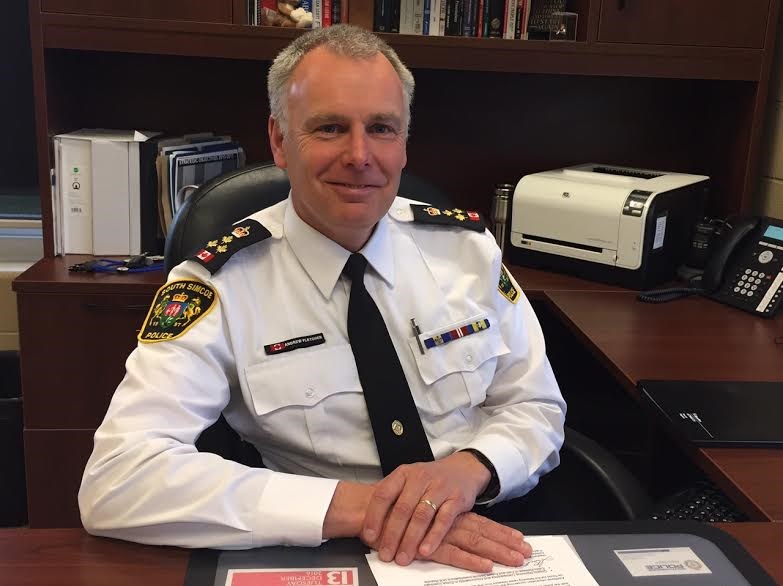The Bradford West Gwillimbury-Innisfil Police Services Board got its first look at the South Simcoe police budget for 2020 and the result was what Innisfil Mayor Lynn Dollin called “sticker shock.”
The $20-million operating budget includes a 6.58 per cent (or $1.25-million) increase over 2019, almost entirely related to six proposed new hirings, as well as negotiated contract increases in salaries and benefits.
“Everything else is zero-based,” said South Simcoe Police Chief Andrew Fletcher, explaining there's an attempt to offset every increase in costs with an equal savings. “But obviously we can’t absorb… the new positions or the negotiated (salary) increases.”
Growth is driving the need for additional staff, Fletcher told board members.
Over the past three years, South Simcoe Police Service has averaged between 24,000 and 26,000 calls for service per year.
This year, it is on track for 33,149 calls by year end.
Innisfil and Bradford West Gwillimbury have seen a 16 per cent increase in investigative services, an 18 per cent increase in break and enters, and a 20 per cent increase in calls involving mischief and property damage. It's also rare that South Simcoe police officers do not receive a weekly call involving weapons or guns.
“We continue to see the types of crime changing,” said the chief, noting that both opioids and gang-related crimes have reached the community.
“Our calls are going up," Fletcher said. "The severity of our calls are going up.”
Across Canada, the officer-to-population ratio is 182 officers per 100,000 people, while the provincial average is 177.
South Simcoe Police Service has 119 per 100,000 residents, on average.
“We’re well below the national average,” Fletcher said. “We’re going to have to bring those numbers up.”
The proposed new hirings would include two new traffic safety officers and four front-line officers.
Fletcher pointed out that increased calls and low staffing levels have led to a rise in overtime paid out in 2019, projected to reach more than $574,000 by the end of this year.
The new hirings will only slightly reduce overtime payments in 2020, the chief added, since it will take nearly a full year to hire and train the new officers.
The police department has made every effort to keep costs in check, Fletcher said.
“We’ve whittled it down and sharpened our pencils,” he added, noting that most of the $1.25-million hike is for salaries and benefits.
Only $236,000 relates to “discretionary spending” on other costs, Fletcher noted.
The 6.58 per cent budget increase does not include a number of grants, which could offset the proposed hike. The police service has applied for approximately $500,000 in various grants, including proceeds of crime, community safety, criminal resources, and civil remedies.
“We’re hopeful those grants will go through,” Fletcher said.
But since the application process is competitive, and the provincial grant cycle doesn’t fit with the budget cycle, “we’ll have to wait," he said. “It’s an extremely frustrating process."
The service is notified of the possible funding at the start of the year, with a March 31 application deadline, but isn't notified until late in the year whether it has been successful, making it difficult to plan.
South Simcoe police will be applying for a share of the new funding to address guns and gangs.
“The challenge will be, the pot of money is shared between every police service in the province," Fletcher said.
If the police service is successful in all of its applications, it would reduce the proposed increase to roughly 3.58 per cent.
South Simcoe police are also proposing a $750,000 capital budget, which includes $375,000 for vehicle replacement.
“Our sedans are on a three-year cycle, SUVs on a four-year cycle,” said Fletcher, adding there's also $200,000 for radio infrastructure upgrades to eliminate “dead” zones in communications.
Dollin suggested that there could be “some synergies with some enterprises” to help cover the cost of new communications towers.
Fletcher agreed with the Innisfil mayor. The chief said that the service will talk to potential private-sector partners to look at ways to “piggyback… but we’re at the point where our system is failing.”
Dollin said she was not prepared to approve the budget request yet.
“I’m worried about sticker shock if we don’t get any more grant funding,” she told the board.
Bradford West Gwillimbury Mayor Rob Keffer also expressed concern over his council’s possible reaction.
“As mayors, we have to be able to work with our councils and make them understand the process,” he said.
Keffer noted the new hirings address public safety and “public safety has always been one of the issues… but at the same time, it’s hard for us to know what our growth is.”
Fletcher pointed out that the police budget makes up just part of municipal taxation and the increase could be at least partially offset by growth in assessment in the two municipalities that share the police department.
“Other than starting to cut services… that’s the budget position,” Fletcher said.
The police services board voted to receive the chief's budget request and refer the figures to the chief financial officers of both municipalities to do the math and look at actual impact on taxpayers.
The information will be brought back to the board at its November meeting for possible approval.
Once approved, the request will be presented to both municipal councils.



